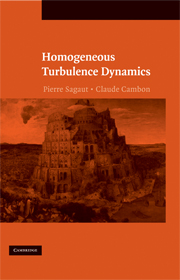Book contents
- Frontmatter
- Contents
- Abbreviations Used in This Book
- 1 Introduction
- 2 Statistical Analysis of Homogeneous Turbulent Flows: Reminders
- 3 Incompressible Homogeneous Isotropic Turbulence
- 4 Incompressible Homogeneous Anisotropic Turbulence: Pure Rotation
- 5 Incompressible Homogeneous Anisotropic Turbulence: Strain
- 6 Incompressible Homogeneous Anisotropic Turbulence: Pure Shear
- 7 Incompressible Homogeneous Anisotropic Turbulence: Buoyancy and Stable Stratification
- 8 Coupled Effects: Rotation, Stratification, Strain, and Shear
- 9 Compressible Homogeneous Isotropic Turbulence
- 10 Compressible Homogeneous Anisotropic Turbulence
- 11 Isotropic Turbulence–Shock Interaction
- 12 Linear Interaction Approximation for Shock–Perturbation Interaction
- 13 Linear Theories. From Rapid Distortion Theory to WKB Variants
- 14 Anisotropic Nonlinear Triadic Closures
- 15 Conclusions and Perspectives
- Bibliography
- Index
6 - Incompressible Homogeneous Anisotropic Turbulence: Pure Shear
- Frontmatter
- Contents
- Abbreviations Used in This Book
- 1 Introduction
- 2 Statistical Analysis of Homogeneous Turbulent Flows: Reminders
- 3 Incompressible Homogeneous Isotropic Turbulence
- 4 Incompressible Homogeneous Anisotropic Turbulence: Pure Rotation
- 5 Incompressible Homogeneous Anisotropic Turbulence: Strain
- 6 Incompressible Homogeneous Anisotropic Turbulence: Pure Shear
- 7 Incompressible Homogeneous Anisotropic Turbulence: Buoyancy and Stable Stratification
- 8 Coupled Effects: Rotation, Stratification, Strain, and Shear
- 9 Compressible Homogeneous Isotropic Turbulence
- 10 Compressible Homogeneous Anisotropic Turbulence
- 11 Isotropic Turbulence–Shock Interaction
- 12 Linear Interaction Approximation for Shock–Perturbation Interaction
- 13 Linear Theories. From Rapid Distortion Theory to WKB Variants
- 14 Anisotropic Nonlinear Triadic Closures
- 15 Conclusions and Perspectives
- Bibliography
- Index
Summary
Physical and Numerical Experiments: Kinetic Energy, RST, Length Scales, Anisotropy
Mean-shear flows are ubiquitous in turbulence. In a real flow, the shear is always created by the no-slip condition on solid walls, except when there is no tangential velocity or when the wall is a belt moving with the same velocity as the flow (shear-free boundary layer). Shear flows are therefore intimately connected with near-wall turbulence dynamics. Nevertheless, many features can be understood in the idealized case of a uniform mean shear in the absence of boundaries, in the context of HAT. The relevance of this idealized model flow was discussed by W. C. Reynolds, among many others. The effect of the wall is to create a mean shear and to block the vertical motion. The arbitrary imposed uniform shear in the HAT framework is also responsible for a reduction of vertical velocity fluctuations (as we shall see with all details in this chapter). Therefore the presence of a wall is not mandatory.
The emphasis in this chapter is put on the departure from isotropy that is due to the application of a constant shear. The main reasons are that it contains all the physical mechanisms present in homogeneous shear flows and that it is the most extensively analyzed flow in this family.
- Type
- Chapter
- Information
- Homogeneous Turbulence Dynamics , pp. 192 - 218Publisher: Cambridge University PressPrint publication year: 2008



